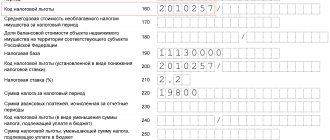Tax abolition: amendments to the Tax Code of the Russian Federation from 2021
In 2021, the objects of property taxation for Russian organizations are generally recognized as movable and immovable property taken into account in the organization’s accounting records as part of fixed assets (clause 1 of Article 374 of the Tax Code of the Russian Federation).
From 01/01/2019 paragraphs come into force. "a" clause 19 of Art. 2 of the Federal Law of August 3, 2018 No. 302-FZ. Changes are made to paragraph 1 of Art. 374 of the Tax Code of the Russian Federation, where the concept of an object of taxation is given. The word “movable” is excluded from the definition of the object of taxation by property tax. That is, starting from 2021, only real estate can be subject to property tax.
Thus, from 01/01/2019, the tax on movable property is abolished in relation to such objects, regardless of the date of their acquisition, or the method or source of receipt of movable property.
Please note that until 01/01/2019, preferential movable property, although not taxed, is reflected in the property tax declaration (calculation) in section 2 in the subsection devoted to calculating the average annual (average) value of property. In addition, preferential movable property and even movable fixed assets of depreciation groups I-II (which, in principle, are not recognized as an object of taxation for property tax) are reflected for reference in the declaration, calculation on lines 270, 210, respectively. From 01/01/2019, the value of movable property will not be shown in the property tax declaration (calculation) for either calculation or reference purposes.
What is considered movable property?
The abolition of the tax on movable property from 2021 once again prompted us to recall what is considered to be this type of property (Article 130 of the Civil Code): any property that is not classified as real estate, which can be moved without causing damage to it, is considered movable. That is, transport, machinery, equipment, inventory, tools, furniture - according to the Civil Code of the Russian Federation, this is all movable property, only air, sea and river vessels are excluded. More precise criteria for distinguishing between real estate and movable property are given in the letter of the Federal Tax Service dated October 1, 2018 No. BS-4-21/ [email protected] Read more about movable property in our article.
From January 1, 2021, due to the amendments specified in paragraph 19 of Art. 2 of the Law on the abolition of the tax on movable property No. 302-FZ, the text of paragraph 1 of Article 374 of the Tax Code is changing. Any movable property becomes non-taxable, that is, the property tax base decreases. Movable objects will no longer be reflected in the tax return, even as a reference.
For which objects will you need to pay tax in 2021?
Based on paragraph 1 of Article 130 of the Civil Code of the Russian Federation, real estate includes land plots, subsoil plots and everything that is firmly connected to the land, that is, objects whose movement without disproportionate damage to their purpose is impossible, including:
- buildings, structures, unfinished construction projects;
- residential and non-residential premises;
- parts of buildings or structures intended to accommodate vehicles (car spaces), if the boundaries of such premises, parts of buildings or structures are described in the prescribed manner.
Real estate also includes objects subject to state registration: aircraft and sea vessels, inland navigation vessels. The Civil Code of the Russian Federation allows other property to be classified as real estate if it is defined by law (for example, space objects).
To confirm the existence of grounds for classifying a property as real estate, the Federal Tax Service of Russia recommends that the tax authorities establish the following circumstances (letter dated 02.08.2018 No. BS-4-21/):
- availability of a record about the object in the Unified State Register of Real Estate;
- in the absence of information in the Unified State Register of Real Estate - the presence of grounds confirming the strong connection of the object with the ground and the impossibility of moving the object without disproportionate damage to its purpose.
For example, for capital construction projects, these may be documents of technical accounting or technical inventory of the object as real estate; permits for construction and (or) commissioning; design or other documentation for the creation of an object and (or) its characteristics.
Read also
08.08.2018
Cancellation of movable property tax from 2021
The tax base in 2021 is recognized as both movable and immovable property, with the exception of (clause 4 of Article 374 of the Tax Code):
- movable property classified in groups I-II of the classification of fixed assets;
- the cost of acquired land plots;
- nuclear equipment, installations and storage facilities;
- space objects;
- icebreakers and ships with nuclear and nuclear installations;
- federal property used for defense and state security, law enforcement by military and equivalent services;
- historical sites recognized as cultural heritage;
- ships listed in the Russian International Register of Ships.
In a number of regions, the rest of movable property (or individual objects) was granted preferential treatment by local legislation in 2021. The average annual cost of such objects was reflected in section 2 of the declaration and was taken into account when filling out lines 210 and 270.
The adoption of a new law abolishing the movable property tax does not change the rules in force this year. If there were benefits, they will remain until the end of 2021; in the 2018 annual declaration, everything is indicated without taking into account new amendments (they will come into force on 01/01/2019).
Latest innovations
From 2021, firms are freed from the need to pay tax on movable objects. However, the conditions of this law differ slightly for different regions.
The changes came into force on the basis of Federal Law No. 302. It came into force on January 1, 2021, so now businesses can avoid paying the fee for various movable objects owned. The changes led to the fact that the tax was completely excluded from the Tax Code.
What is movable property?
The definition of movable property is contained in the Civil Code of the Russian Federation. Real estate includes different plots of land, apartments, houses or rooms. They are represented by objects that cannot be moved without causing significant damage. Therefore, even unfinished construction projects are included here.
All real estate objects are subject to official state registration. Therefore, sea vessels or space objects are additionally included in these categories.
From 2021, movable property is not subject to corporate property tax:
All other things that are not real estate are movable property. This even includes money and securities. There is no requirement to register your right to these items, but there are some exceptions prescribed by law.
Based on Art. 374 of the Tax Code until 2021, to calculate the levy on movable property, the provisions of Art. 130 NK. Since the beginning of this year, this type of tax has been excluded from the Tax Code.
Examples of property
Real estate represents various objects that are inextricably linked with the land. These include houses, garages, dachas, plants or factories. Additionally, these include sea vessels and space objects.
Movable objects include securities, cars or money.
New reduction factors
In 2021, all of Russia will switch to calculating property taxes for individuals based on the cadastral value of real estate. According to this principle, property taxes began to be calculated in 2015 in the first 28 regions. Since 2021, 21 regions have been added to them, and last year, 2021, another 15 constituent entities of the Russian Federation.
The maximum tax rate is 0.1% of the cadastral value of the taxable property. But for the comfortable transfer of payers to the new payment system, in order to avoid a sharp increase in the amount of tax, a tax calculation system with decreasing coefficients was developed. Every year the coefficient increases, and along with it the amount of tax increases, in particular:
- for regions that switched to cadastral value in 2015, the coefficient for the tax period of 2021 is 0.6;
- for regions from 2021 - with a coefficient of 0.4;
- for regions from 2021 - coefficient 0.2.
The growth is 20% per year. But Vladimir Putin, at the end of last year, proposed to clarify the mechanism for calculating property tax for individuals, since the cadastral value at which the tax is calculated often exceeds the market value. “The cadastral value of real estate often significantly exceeds the market value. We didn’t agree that way,” the head of state said then. And now there is already a law in force, which came into force on August 4, but has extended its effect to legal relations of past years. Amendments have been made to Article 408 of the Tax Code of the Russian Federation, and now the amount of property tax for individuals will increase by no more than 10% per year compared to the previous year. To do this, for the first 3 tax periods from the beginning of application of the procedure for determining the tax base based on the cadastral value of the taxable object, a special formula with a reducing coefficient will be applied, which will be equal to:
- 0.2 - in relation to the first tax period in which the tax base is determined in the corresponding municipality (federal city of Moscow, St. Petersburg or Sevastopol) in accordance with Article 403 of the Tax Code of the Russian Federation;
- 0.4 - in relation to the second tax period, in which the tax base is determined by the cadastral value;
- 0.6 - in relation to the third tax period, in which the tax base is determined by the cadastral value.
Starting from the fourth tax period, in which the tax base is determined by the cadastral value, the tax amount is calculated without taking into account the formula and reducing factors, and its growth should not exceed 10% per year. In 2021, this rule will be applied in 28 constituent entities of the Russian Federation, where the tax is calculated with a coefficient of 0.6.
Movable property tax: current rates and conditions of application
Clause 3.3 of Art. 380 of the Tax Code of the Russian Federation establishes the maximum rate for tax on movable property - 1.1%. From 2021, the rate limit will double to 2.2%.
Based on the norms of the listed articles of tax legislation and laws adopted by the constituent entities of the Russian Federation, in different regions of the country today there are different tax rates and benefits in relation to the movable property of enterprises, with the exception of objects acquired from related parties and transferred during the reorganization or liquidation of companies. There is no point in comparing the rates set by regions; we can only state the fact that in some regions a maximum tax rate has been established, in others a lower rate has been introduced, and in others there is a tax exemption.
Enterprises are required to pay tax on OSNO. , and applying special tax regimes, still do not pay property tax, with the exception of some real estate objects recorded at cadastral value and indicated in the list determined in accordance with clause 7 of Art. 378.2 Tax Code of the Russian Federation.
Thus, companies that own movable property, when calculating the tax payable, must be guided not only by tax legislation, but also by regional acts.
New procedure for calculating property tax from 2021
READ ON THE TOPIC:
From January 1, 2021, non-working pensioners and disabled people will be given a benefit for major repairs.
How to properly formalize and receive it With the entry into force of a new law signed by the head of state, the mechanism for calculating tax based on cadastral value (property tax, land tax) is being adjusted.
The new document involves abandoning the use of the 0.8 coefficient in the tax calculation formula. That is, the coefficient will reach a value of 0.6
and it won't grow anymore.
In addition, the amendments introduce a 10 percent limit on the increase in the amount of tax payable for the previous year. They also exclude the possibility of recalculating the tax “retroactively” if the adjustment does not lead to a reduction in payment.
As for challenging the results of the cadastral value, if the taxpayer was able to prove that it was calculated incorrectly, the law prescribes the use of the changed cadastral value when calculating the tax.
And not from the year in which the statement of disagreement with the assessment results was filed, but from the moment when the erroneous value began to be applied.
The annual increase in the amount of property tax based on cadastral value is now limited to 10 percent.
What is considered movable property?
Tax officials indicated that the legal grounds for classifying an object as movable or immovable property must be determined by the norms of civil legislation on the conditions for recognizing a thing as movable or immovable, in particular by the norms of Articles 130-131 of the Civil Code of the Russian Federation.
Movable property
- this is property whose parameters do not allow it to be classified as real estate. A characteristic feature of such material assets is the possibility of their transfer from one individual to another.
Legislative: Articles 130-131 of the Civil Code of the Russian Federation
READ ON THE TOPIC:
What's new in tax legislation since 2021: VAT, individual entrepreneurs, property, taxes, excise taxes, duties
1. Immovable things (real estate, real estate) include land plots, subsoil plots and everything that is firmly connected to the land, that is, objects the movement of which without disproportionate damage to their purpose is impossible, including buildings, structures, unfinished construction objects.
(as amended by Federal Laws dated December 30, 2004 N 213-FZ, dated June 3, 2006 N 73-FZ, dated December 4, 2006 N 201-FZ). Immovable property also includes aircraft, sea vessels and inland navigation vessels subject to state registration. The law may classify other property as immovable property. (as amended by Federal Law No. 216-FZ dated July 13, 2015) Real estate includes residential and non-residential premises, as well as parts of buildings or structures intended to accommodate vehicles (parking spaces), if the boundaries of such premises, parts of buildings or structures described in the manner established by the legislation on state cadastral registration. (paragraph introduced by Federal Law dated July 3, 2016 N 315-FZ)
2. Things not related to real estate, including money and securities, are recognized as movable property
. Registration of rights to movable things is not required, except in cases specified in the law.
Thus, in accordance with the explanations of the Federal Tax Service of Russia, a taxpayer-legal entity, in order to confirm that it has grounds for classifying an object of property as real estate, must prove to the tax authority the presence of the corresponding signs. Among these, tax authorities will take into account such circumstances as:
- the presence or absence of a record about the property in the Unified State Register of Real Estate;
- in the absence of such information in the register - the presence or absence of a strong connection with the land;
- the impossibility of moving an object without causing great damage to its purpose.
In particular, with regard to capital construction projects, tax authorities will request from taxpayers:
- documents of technical accounting or technical inventory of an object as real estate;
- building permits;
- permits for commissioning;
- design or other documentation for the creation of a real estate property;
- information about its characteristics.
As the Federal Tax Service of Russia reports, in addition, during a tax audit of corporate property tax reporting, tax inspectors can conduct inspections, order examinations, attract specialists of the required profile, and demand documents and (or) information from taxpayers. True, only if there are and within the framework of the grounds provided for by the Tax Code of the Russian Federation.
What is property tax
In Russia, property rights must be paid to the state in the form of a tax. This applies to both real estate (land, houses, apartments, commercial real estate) and cars. Moreover, in some cases, the amount of tax can be significant, for example, when the cadastral value of the property is high, or due to the large amount of horsepower in the car.
Property tax is regulated by Ch. 32 of the Tax Code of the Russian Federation. It is worth noting that tax rates, as well as additional benefits, can be set by regions.










